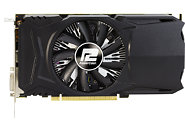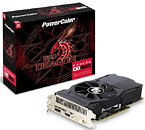Friday, April 21st 2017

PowerColor Announces the Radeon RX 550 RedDragon
TUL Corporation, a leading and innovative manufacturer of AMD graphic cards since 1997, has released a new PowerColor Red Dragon RX 550 2GB GDDR5 added in the line of RX 500 series. It is based on AMD's latest GCN 4 architecture designed for GloFo 14nm FinFET that delivers premium VR capability, increased level of performance, smooth VR, seamless support for next-gen gaming monitors and CPU-free game streaming or recording.
Furthermore, the model also supports AMD's optimized DirectX 12,Vulkan Gaming, Radeon FreeSync, and Liquid VR. It has the features of AMD's newest technology called Radeon ReLive which supports 4K, 30 & 60FPS, HEVC & H.264 providing you smooth recording on lower power systems, and Radeon Chill which is an intelligent power-saving feature that regulates dynamically frame rate based on your movement's in-game.PowerColor Red Dragon RX 550 2GB GDDR5 utilizes 2GB of GDDR5 memory with 512 stream processors, ships with 1190MHz core clock speed, and has 1750MHz (7.0Gbps) memory clock speed which is connected via a new high speed 128-bit memory interface.
To support proper cooling systems for the heat dissipation, RX 550 2GB adopts the one ball + one sleeve fan which increases longevity and efficiency. Besides, the performance is higher 2X than R7 250.
Furthermore, the model also supports AMD's optimized DirectX 12,Vulkan Gaming, Radeon FreeSync, and Liquid VR. It has the features of AMD's newest technology called Radeon ReLive which supports 4K, 30 & 60FPS, HEVC & H.264 providing you smooth recording on lower power systems, and Radeon Chill which is an intelligent power-saving feature that regulates dynamically frame rate based on your movement's in-game.PowerColor Red Dragon RX 550 2GB GDDR5 utilizes 2GB of GDDR5 memory with 512 stream processors, ships with 1190MHz core clock speed, and has 1750MHz (7.0Gbps) memory clock speed which is connected via a new high speed 128-bit memory interface.
To support proper cooling systems for the heat dissipation, RX 550 2GB adopts the one ball + one sleeve fan which increases longevity and efficiency. Besides, the performance is higher 2X than R7 250.




10 Comments on PowerColor Announces the Radeon RX 550 RedDragon
There are some available already, but still too pricey.
Also, I love how they're marketing this card as great for "CPU-free game streaming or recording" a month after they said that maybe Ryzen is slower than i7 in gaming, but the extra cores are great for streaming. :)
Honestly: IMO RX560-580 are big disappointments. RX550 at least gives us a card more affordable than RX460 (and maybe less power-hungry).
I'm still waiting for reviews of the low-end stuff: 520-540. That seems to be the only interesting thing in this Polaris refresh. :)
I have to say... the products they released this year vary in quality (Ryzen easily at the top, followed by so-so chipsets and poor GPUs).
But the advertising and sales strategy? The hype? The very careful control of "leaks"? All excellent.
History of Ryzen launch could join the canon of examples analyzed on marketing studies. It's not just food, cars and cloths any more - PC parts are joining the party :)
The argument about streaming was used a lot - both by AMD and consumers. Directly after the launch journalists often mentioned that streaming is usually done by GPU anyway, but these voices have faded out in reviews dominated by the excellent benchmark results. :)
I'm by no means trying to discredit the potential of latest AMD's products. But how they've organized the whole release schedule is really impressive (now we know that showing Ryzen 5 a month after 7 was just a first step :)).I think 40W is what AMD should be targeting - paired with either large passive cooling or simple fans (like with HD7750). It still leaves some space for cheaper models with - potentially - even lower power needs (and these could be passive and single-slot by default).
And I quite miss the HD7750 as well. :D Such a great budget GPU. That was basically the only AMD GPU I considered since the 9500/9600 years ago. Today I'm just to attached to CUDA anyway.